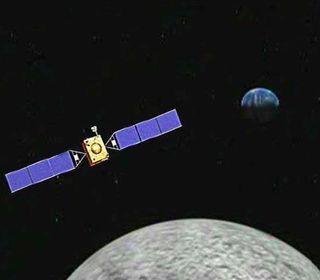
China Outlines Two-Phase Chang'e 4 Moon Lander Mission

Later this year, the moon's far side will welcome its first robotic visitor — China's Chang'e 4 lander.
Zhao Xiaojin, a senior official at the China Aerospace Science and Technology (CAST), explained that the nation's two-phase Chang'e 4 mission is being readied for launch this year.
"In the first half of 2018, we will first launch a relay satellite to Lagrange L2 Point, where the satellite can keep communication with both the far side of the moon and the Earth," Zhao told China Central Television (CCTV) earlier this month. (The L2 Point is a gravitationally stable spot beyond the moon's far side.) [China's Moon Missions Explained (Infographic)]
"Therefore, we can control the lunar probe for data transmission using this relay satellite," Zhao added.
Launch of the Chang'e 4 lander is slated for the second half of 2018. After performing a soft touchdown on the lunar far side, the craft will "conduct in-situ and patrol exploration at the landing site," Zhao said.
Moon exploration program
China's Chang'e lunar exploration program takes its name from a Chinese moon goddess. The program's first phase consisted of the successful Chang'e 1 and Chang'e 2 missions, which lifted off in 2007 and 2010, respectively.
Chang'e 3 marked the beginning of the second phase, which includes orbiting the moon, landing and returning lunar samples to Earth. In 2013, Chang'e 3 performed the nation's first-ever soft landing on the moon; the lander also deployed a rover known as Yutu ("Jade Rabbit").
Get the Space.com Newsletter
Breaking space news, the latest updates on rocket launches, skywatching events and more!
Chang'e 4 was built as the backup to China's Chang'e 3 probe. But Zhao told CCTV that Chang'e 4's mission profile differs in key ways from that of Chang'e 3
"Chang'e 3 lunar probe used a slow and arc-shaped landing, while as for Chang'e 4 lunar probe, we have to adopt a steep and almost vertical landing," Zhao explained. "Chang'e 4 lunar probe will have huge improvements on its capabilities, because we have adopted new technologies and new products. For example, Chang'e 3 lunar probe could not work during the night, but Chang'e 4 lunar probe can do some measurement work at night."
Polar exploration
Last year, Pei Zhaoyu, deputy director of the Lunar Exploration and Space Program Center with the China National Space Administration (CNSA), told attendees at the 7th CSA-IAA Conference on Advanced Space Technology that China will implement three missions in the polar regions of the moon and set up scientific research stations there to offer a platform for future lunar probes.
"We will carry out three missions at the moon's polar regions to research the geological structure and mineral composition of its south pole, and we will take samples back from the moon during one of these missions," Pei told CCTV. "By building scientific research stations on the moon, we want to provide a platform for larger-scale and more rich lunar probe activities in the future."
China's blossoming robotic moon-exploration agenda suffered a setback last year, however: the July launch failure of the country's most powerful rocket, the Long March 5, on its second flight. That heavy-lifter is needed to launch China's planned lunar sample-return mission, Chinese officials have said.
This story has more information about the repercussions of the Long March 5 failure. And to learn more about Chang'e 4, check out this Gallery Military video.
Leonard David is author of "Mars: Our Future on the Red Planet," published by National Geographic. The book is a companion to the National Geographic Channel series "Mars." A longtime writer for Space.com, David has been reporting on the space industry for more than five decades. Follow us @Spacedotcom, Facebook or Google+. This version of the story published on Space.com.
Join our Space Forums to keep talking space on the latest missions, night sky and more! And if you have a news tip, correction or comment, let us know at: community@space.com.

Leonard David is an award-winning space journalist who has been reporting on space activities for more than 50 years. Currently writing as Space.com's Space Insider Columnist among his other projects, Leonard has authored numerous books on space exploration, Mars missions and more, with his latest being "Moon Rush: The New Space Race" published in 2019 by National Geographic. He also wrote "Mars: Our Future on the Red Planet" released in 2016 by National Geographic. Leonard has served as a correspondent for SpaceNews, Scientific American and Aerospace America for the AIAA. He has received many awards, including the first Ordway Award for Sustained Excellence in Spaceflight History in 2015 at the AAS Wernher von Braun Memorial Symposium. You can find out Leonard's latest project at his website and on Twitter.
